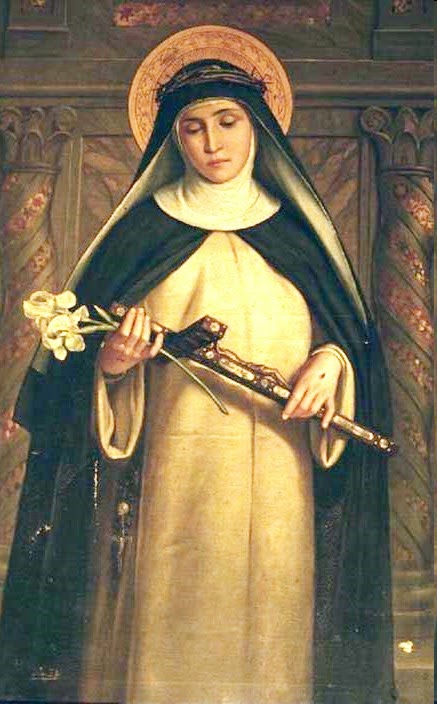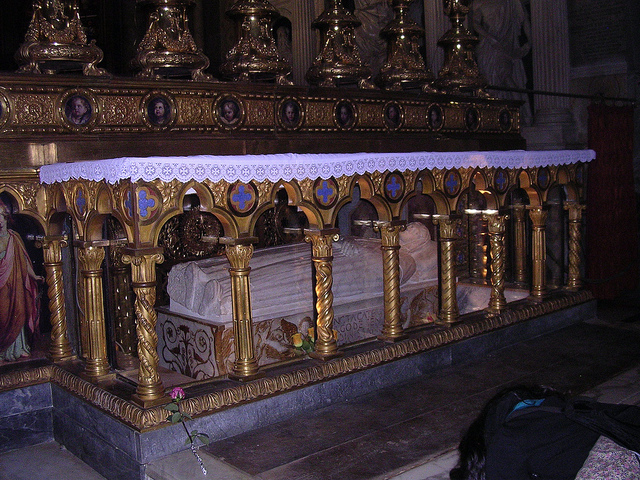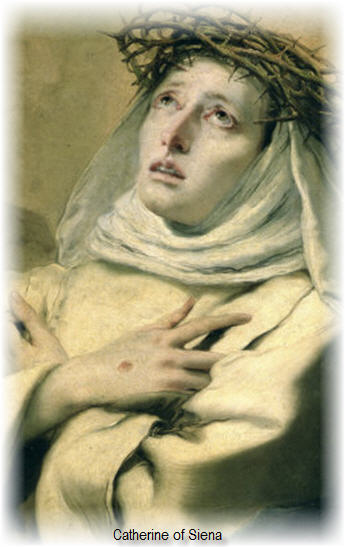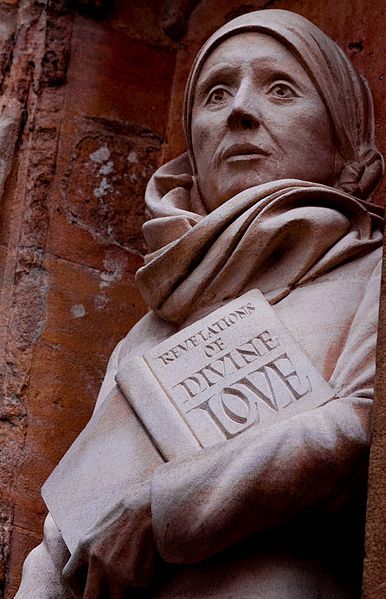 Catherine of Siena (1347-1380), fourteenth century Christian mystic and writer, lived during a time of decline in the world. There were plagues, economic disasters, and political corruption. The Church was in turmoil. There were two popes in Catherine’s time, one in Avignon and one in Rome. Catherine was called by God to mediate conflicts in the Church and Society. Catherine became an advisor to political leaders and popes.
Catherine of Siena (1347-1380), fourteenth century Christian mystic and writer, lived during a time of decline in the world. There were plagues, economic disasters, and political corruption. The Church was in turmoil. There were two popes in Catherine’s time, one in Avignon and one in Rome. Catherine was called by God to mediate conflicts in the Church and Society. Catherine became an advisor to political leaders and popes.
Catherine was named a Doctor of the Church in 1970 by Pope Paul VI. She was the first woman to be published in the Italian dialect. Her writings are still published and read by many in many languages. How did this come about?
Catherine was born in 1347 in Siena, the twenty-fourth child of Giacomo and Lapa Benincasa. Giacomo was a prosperous dyer and they had a very large home. At age six, Catherine had a remarkable experience. On the way home from visiting a sister she had a vision of heaven. At age seven she took a vow to devote her life to Christ. She refused all of her mother’s marriage plans for her and devoted her life to solitude and prayer. At age sixteen she joined the third order of the Dominican laywomen called the Mantellate. These women went throughout the streets in their familiar black and white robes serving the poor. They also maintained a highly contemplative life.
About this time the dreaded Black Plague had been killing thousands of people. Catherine fearlessly nursed the sickest people. While administering to the needs of her patients she also gave them spiritual advice. Her personal charm and down home wisdom won many friends for her.
Her piety convinced many that she was truly a woman of God to follow. Of course, this made enemies for her too. Some thought of her as just a fanatic. Later, when she had some influence among the church leaders she would be accused of just being a political manipulator. And many did not understand her mysticism.
But Catherine had the ability to discern the state of a soul and she witnessed to many lost people and won many to Christ. People began to flock to her for advice. Word of her wisdom got to Avignon and the cardinals invited her to come and speak to them. Actually they were hoping to use her as an envoy to Rome to convince the people there to renounce the pope in Rome and to follow the pope in Avignon. But Catherine believed that the papacy belonged in Rome and worked to that end for the rest of her short life. She literally wore herself out and died at age 33 in Rome. (There are more details about this in my first post on Catherine of Siena, November 20, 2012.)
lost people and won many to Christ. People began to flock to her for advice. Word of her wisdom got to Avignon and the cardinals invited her to come and speak to them. Actually they were hoping to use her as an envoy to Rome to convince the people there to renounce the pope in Rome and to follow the pope in Avignon. But Catherine believed that the papacy belonged in Rome and worked to that end for the rest of her short life. She literally wore herself out and died at age 33 in Rome. (There are more details about this in my first post on Catherine of Siena, November 20, 2012.)
In this post let us look at another aspect of her life – her mysticism and her writing. Catherine led a very active life – full of travels, counseling, and writing. She kept several scribes busy writing letters and several longer works. One work is the “Dialogue”. This was a theological work written in 1377-1378 as a conversation between the “Eternal Father” (God the Father) and a “human soul” (Catherine). Using this method of dialogue, Catherine gives us her theology. The “Eternal Father” exhorts the soul to prayer, works of charity, virtue, and obedience. In the following passage Catherine explains our need for an atoning Savior:
Wherefore I have told you that I have made a Bridge of My Word, of My only-begotten Son, and this is the truth. I wish that you, My children, should know that the road was broken by the sin and disobedience of Adam, in such a way, that no one could arrive at Eternal Life. Wherefore men did not render Me glory in the way in which they ought to have, as they did not participate in that Good for which I had created them, and My truth was not fulfilled. This truth is that I have created man to My own image and similitude, in order that he might have Eternal Life, and might partake of Me, and taste My supreme and eternal sweetness and goodness. But, after sin had closed Heaven and bolted the doors of mercy, the soul of man produced thorns and prickly brambles, and My creature found in himself rebellion against himself.
And the flesh immediately began to war against the Spirit, and, losing the state of inno- cence, became a foul animal, and all created things rebelled against man, whereas they would have been obedient to him, had he remained in the state in which I had placed him. He, not remaining therein, transgressed My obedience, and merited eternal death in soul and body. And, as soon as he had sinned, a tempestuous flood arose, which ever buffets him with its waves, bringing him weariness and trouble from himself, the devil, and the world. Every one was drowned in the flood, because no one, with his own justice alone, could arrive at Eternal Life. And so, wishing to remedy your great evils, I have given you the Bridge of My Son, in order that, passing across the flood, you may not be drowned, which flood is the tempestuous sea of this dark life. See, therefore, under what obligations the creature is to Me, and how ignorant he is, not to take the remedy which I have offered, but to be willing to drown.
The “I” in the dialogue is God the Father explaining why man cannot reach Him without His provision. The provision is a “bridge” – the Lord Jesus Christ. The soul can only come back to God through Christ. It is interesting that Catherine also shows how sinful, ignorant men choose to go their own way and refuse God’s merciful provision. Only the humble soul will turn to God and accept God’s way for salvation.
There are many other theological themes covered – the Trinity, Humanity, Self-Knowledge, and Humility to name a few. Catherine’s use of imagery, metaphor, and everyday scenes from life make her works easy to read. We can appreciate her writing all the more when we realize that she suffered slander, ridicule, and violence throughout her life. She was often weak from fasting, yet she persevered. She did not teach her followers anything that she was not ready to live up to herself.
Catherine’s theology is still relevant today. She identified with Christ and this gave her the courage to persevere in her calling. Her theology is grounded in her denial of her self and total willingness to give God the glory for everything. We admire her for her courage, strong-willed determination, and obedience to God no matter what. Catherine calls us to lives of humility, grace, holiness, love and discipleship.




